Add an SaaS API Rule to the Data Loss Prevention Policy
Configure an SaaS API Rule to set the criteria as to what triggers the scanning. As files in the selected tenant are scanned upon content change and context (sharing) change, Secure Access assesses the file against this rule’s criteria. If a match is made, this rule’s action is immediately enforced. If Secure Access detects a violation, the offending file is listed in the Data Loss Prevention Report.
An SaaS API Rule must have at least one of the following three criteria defined:
- Data Classifications — Include files that match data classification of your own making or a built-in data classification provided by Secure Access.
- File Labels — Include files that have specific . file label names configured in the value of the files' document properties.
- File Size — Include files that meet custom size criteria.
Note: Changes to the share permissions or other options on a folder does not trigger a scan of the contents of that folder.
SaaS API rules configured to scan Microsoft Outlook messages scan only outgoing messages. Violations can be triggered by material found in the email subject, message body, or attachments; a single email message may trigger multiple violations: one for the message subject and body, and one for each attachment.
- Navigate to Secure > Policy > Data Loss Prevention Policy, click Add Rule, and choose SaaS API Rule.
- In the Add New SaaS API Rule page, enter a meaningful Rule Name and Description. Choose a Severity value from the drop-down based on the risk involved or importance within the ruleset. (Assigning severity values can help later on when you need to filter events in the Data Loss Prevention report.)
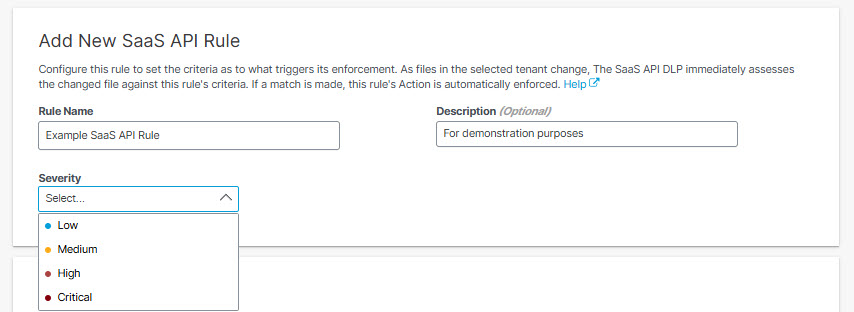
- Under Data Classifications select where in scanned files you would like this rule to search for the data classifications that you choose:

Content—(Default) Scans only the content of files for the selected data classifications. (For Outlook this option scans the subject line and message body of incoming email, and the file content of attachments to incoming email.)
File Name—Scans only file names for the selected data classifications. (For Outlook this option scans the subject line and message body for incoming email, and the file name for attachments to incoming email.)
Content and File Name—Scans content and file names for the selected data classifications. Both content and file name do not need to match for the rule to apply, only one or the other.Note: Choosing Content, File Name, or Content and File Name refers to scanning file uploads for the selected data classifications and configured file labels.
- Select Data Classifications to apply this rule; you can choose a data classification of your own making or a built-in data classification provided by Secure Access. (See Manage Data Classifications and Built-In Data Classification Templates.) Hover over PREVIEW to view data identifiers associated with each data classification.
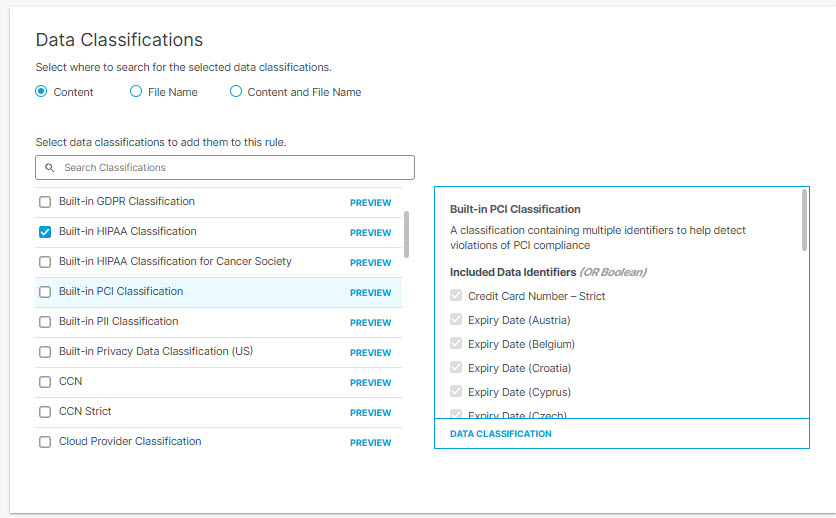
- Add up to 10 case-sensitive file label names to apply to this rule. The rule will search for any of the configured file label names in the value of the files' document properties. This includes:
Microsoft Office Document Properties
Microsoft Office Sensitivity Labels
Adobe PDF Document Properties
For Outlook, this applies to files attached to incoming email. File uploads to Confluence and Jira are not scanned for file labels.
Microsoft Sensitive Labels
Secure Access currently supports the detection of Microsoft sensitivity labels in the file properties’ values of the inspected file for Microsoft Word, Excel, PowerPoint, and .pdf files. Ensure you configure the rule with the name of the sensitivity labels, not the Display Names.

- The File Size area has two use cases:
- In a rule that specifies a custom file size but no other criteria, DLP applies the rule action to files that match the file size criteria, regardless of content. (This may be useful in situations where you want to exclude certain low-risk files below a certain size from inspection, so as not to waste processing time on insignificant events.)
- In a rule that specifies a custom file size along with other criteria such as Data Classification, the DLP applies the rule action to files that match the other criteria within the file size specified up to the first 50 MB of plain text. (Secure Access does not scan file content beyond the first 50 MB regardless of the file size specified here.)
In the File Size area choose from two options:
- All Sizes to scan up to the first 50 MB of plain text of all files that meet other criteria defined by this policy. (A rule that specifies All Sizes must also specify either Data Classifications or File Labels or both.)
- Custom Size to specify the minimum and maximum size limits the system will scan for files that meet other inclusion criteria defined by this rule, if there are any. If the file size exceeds the first 50 MB of the file, Secure Access scans only up to the first 50 MB of plain text in the file. (I.e., if you specify a minimum file size greater than 50 MB, Secure Access will not scan for other criteria specified in the rule.)
You can choose to apply the rule action only to files that are greater than a minimum size you specify, or to files that are within a range of sizes you specify. (If you specify a maximum size without specifying a minimum size, the minimum size defaults to 0.) You can specify file sizes in KB or MB.

- In the Platform area, select one platform and tenant for this rule. Only platforms with authorized tenants will appear in the list.
Note: When you select Microsoft 365 you can select both OneDrive and SharePoint, but you cannot select Outlook in combination with Microsoft OneDrive or SharePoint in the same rule.
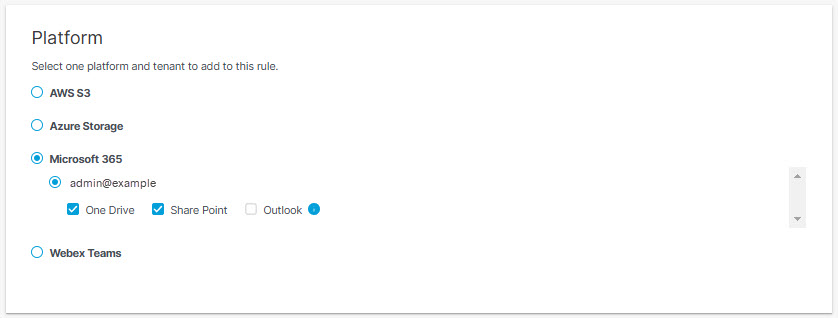
- In the Include and Exclude area, select users whose files are included or excluded from scanning for this rule. Make selections to include or exclude users from being matched. (For Outlook, user refers to the email sender.)
- Click the Include all users radio button to scan files from all users, including external collaborators.
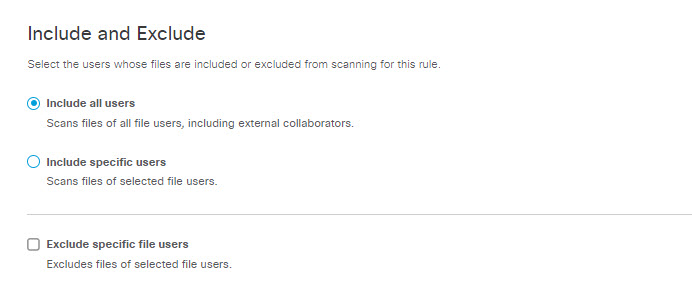
- Click the Include specific users radio button to scan files from users selected in one of the following ways:
- Check the Select users check box to include scanning for selected users as per the rule. You can select the entire AD group or search for identities by AD username or AD Group. The selected identities appear in the box on the right.
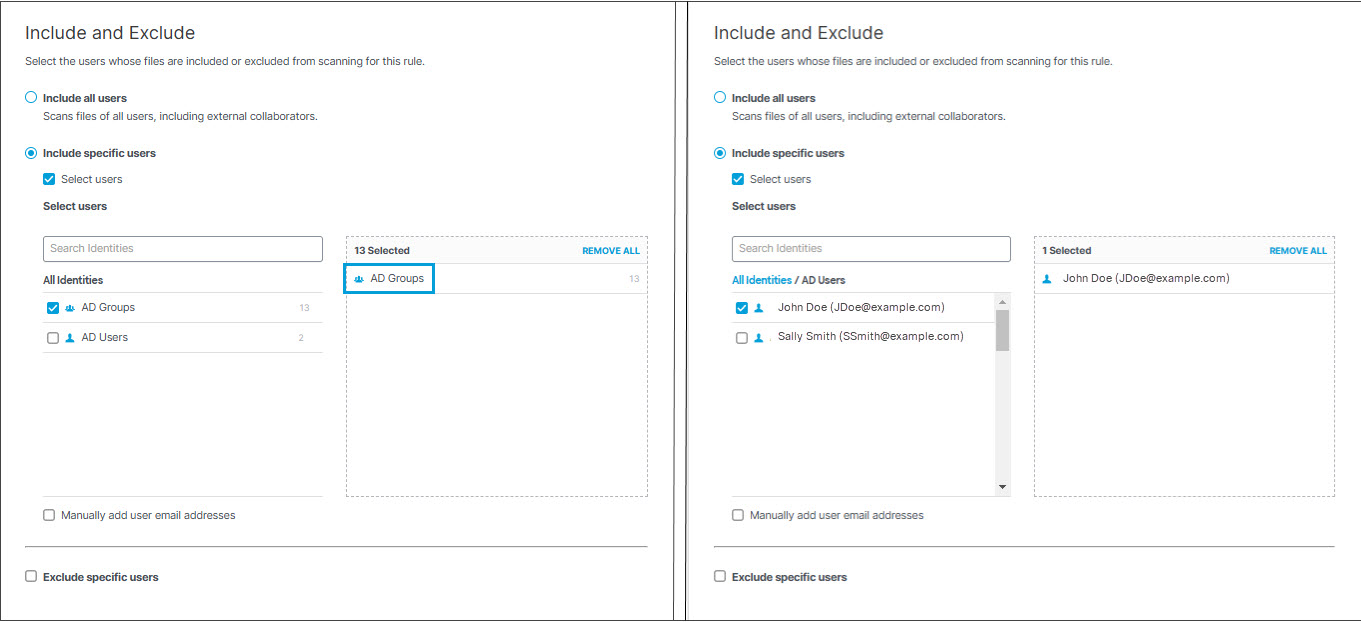
Note: Identities added to a category after the category has been included or excluded from a rule will be included or excluded from the rule as if they were part of the category at the time the rule was created.
- Check the Manually add user domain destinations check box to specify domains where rules will apply to users within those domains.
This option appears only if you have chosen Outlook or Webex Teams for Platform. You can enter a maximum of 1,000 user domain destinations.
- For Outlook Secure Access scans message recipients for domain destination matches.
- For Webex Teams Secure Access scans the Webex space owner for domain destination matches.
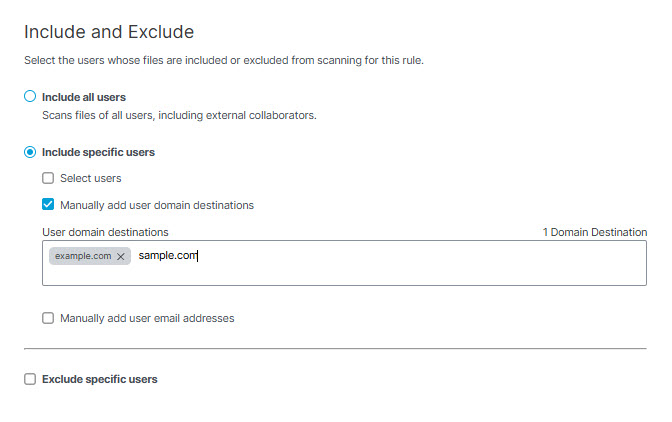
- Check the Manually add user email addresses check box to specify email addresses of file owners to which the rule will apply.
Enter the users' email addresses in the text box.
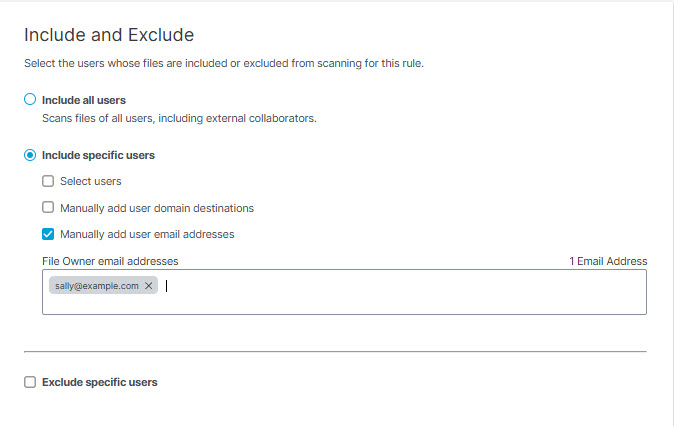
- Check the Exclude specific file users check box to exclude selected users from being matched by this rule. Similarly to selecting identities for inclusion, you can select all AD groups, All AD Users, individual groups, or individual users. Search for identities by AD user name or by AD Group name. Selected identities will appear in the box on the right.
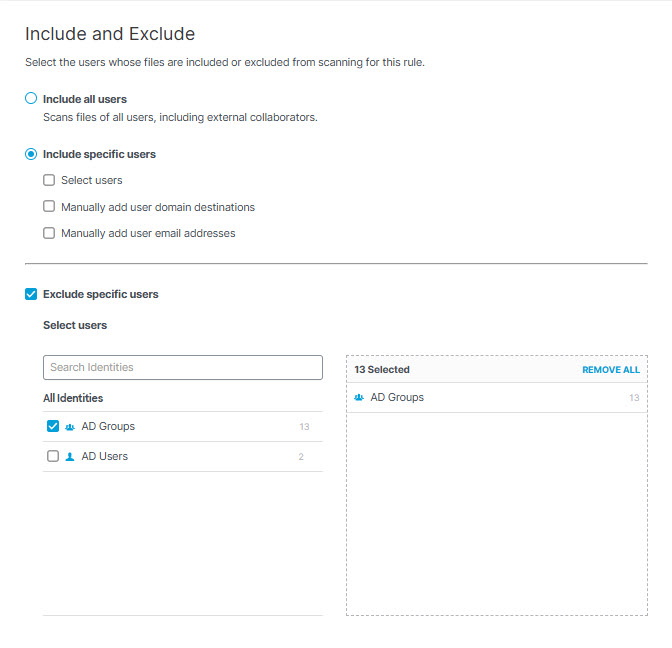
- The Resource Labels area appears only if you have selected AWS or Azure for Platform. In the Resource Labels area, enter key/value pairs you have applied as tags to objects in AWS S3 buckets or Azure storage accounts or containers. Each resource label you enter here identifies the data Umbrella will monitor within your buckets (for AWS) or storage accounts or containers (for Azure). It may take a few minutes for resource labels you enter here to propagate to the policy page, depending on how many there are and the state of the discovery process.

- The Resources area appears only if you have selected AWS S3, Azure Storage, or Webex for Platform.
Under Resources make selections to define S3 buckets (for AWS) or containers (for Azure) to include or exclude from being matched by this rule:
- Click the Include all resources radio button (the default) to include all resources available on your platform for scanning. for all the S3 buckets (for AWS) or storage accounts or containers (for Azure) associated with your account (including non-admin resources).

- Click the Include specific resources radio button to display a list of resources available and select the ones you want to include for matching.
- For AWS you can select S3 buckets
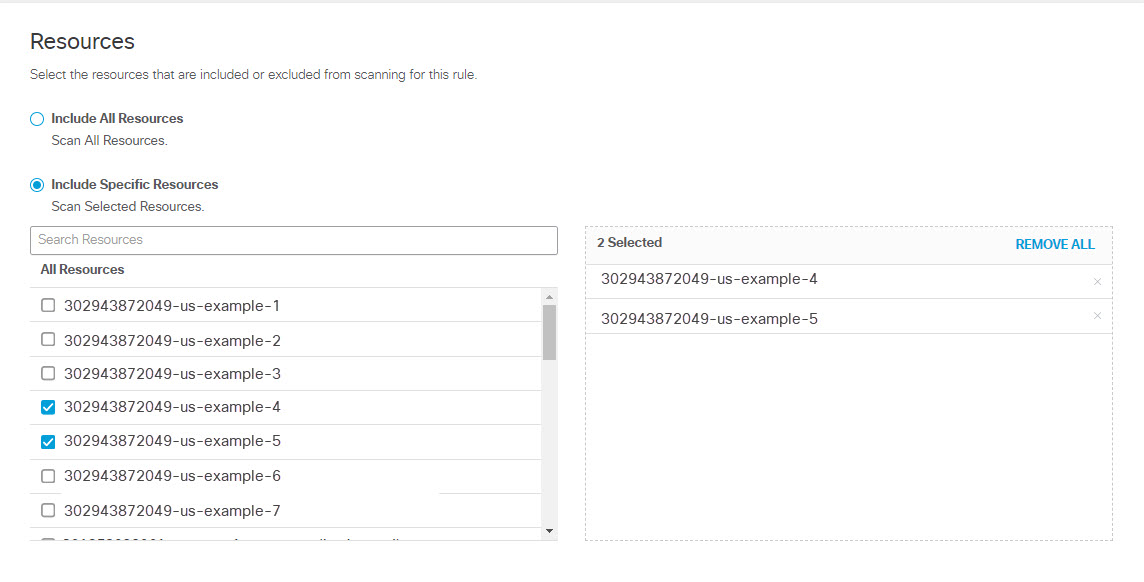
- For Azure you can select containers
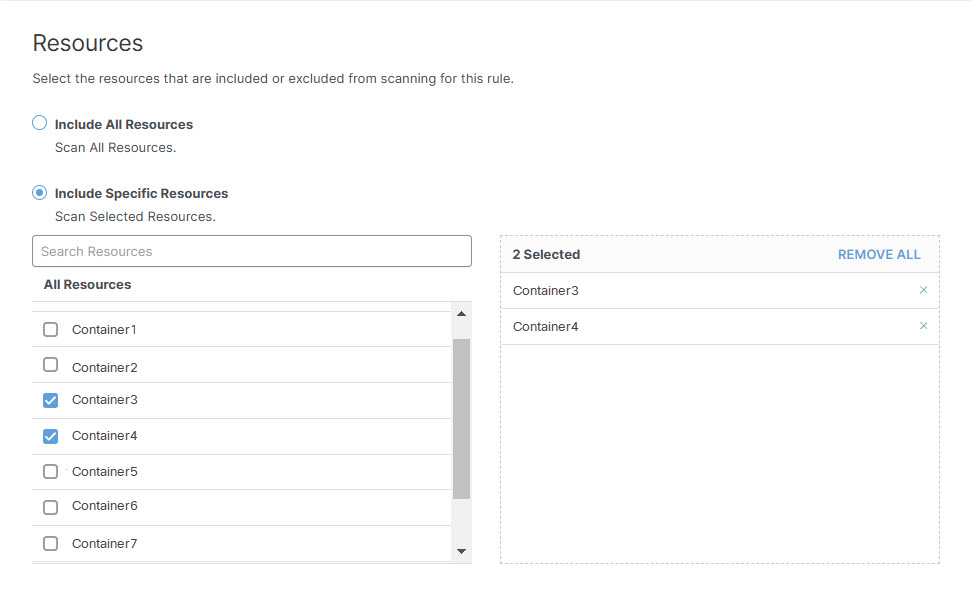
- For Webex you can select Webex Teams and Webex Spaces
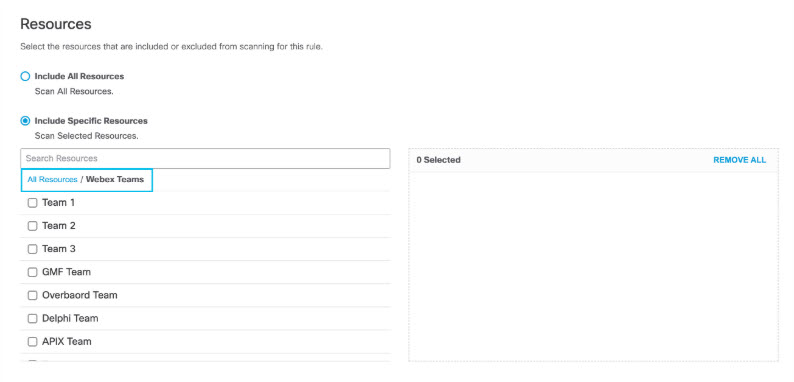

- Under Exposure, optionally select the file sharing permissions to consider when processing files to search for data violations:
- Shared Publicly- Accessible to all users with the link to the file.
- Shared with External Users- Shared with users who do not belong to the authorized domains.
- Domain-wide Share- Shared with all users in a domain.
- Shared with Internal Users- Shared with users who belong to the authorized domains.
- Shared with Specific Users- Shared with specific users by their email addresses.
The table below indicates which Exposure settings are available for each platform:
| Shared Publicly | Domain-wide share | Shared with internal users | Shared with external users | Shared with specific users | |
|---|---|---|---|---|---|
| AWS S3 | ✓ | — | ✓ | — | — |
| Azure Storage | ✓ | — | ✓ | — | — |
| Box | ✓ | — | — | ✓ | ✓ |
| Dropbox | ✓ | ✓ | ✓ | ✓ | ✓ |
| ✓ | ✓ | ✓ | ✓ | ✓ | |
| Microsoft Office 365 SharePoint Online | ✓ | ✓ | ✓ | ✓ | ✓ |
| Microsoft Office 365 OneDrive | ✓ | ✓ | ✓ | ✓ | ✓ |
| Microsoft Office 365 Outlook | — | — | ✓ | ✓ | ✓ |
| Service Now | ✓ | ✓ | — | ✓ | ✓ |
| Slack | — | ✓ | ✓ | ✓ | ✓ |
| Webex Teams | — | — | ✓ | ✓ | ✓ |
- A DLP rule can be configured with either Data Classifications, File Labels or both. Exposure is an optional criterion.
- When a DLP rule is configured with all 3 criteria, then a DLP event is raised when any of the selected Data Classifications and when any of the configured file labels are detected in the inspected file and when the file’s permissions match any of the selected exposure settings.
- From the Action drop-down list, choose Monitor, Quarantine, Delete or Revoke Access.
- Monitor- Detects and logs a DLP event for every modified file violating this rule’s criteria
- Quarantine- Isolates a file that violates the rule criteria to the quarantine folder and revokes all shares
- Delete- Permanently deletes when a change is detected that violates the rule criteria (This option is available only for Webex Teams, and applies for a violation within a post, as well as a violation within a file attached to a post.)
- Revoke Access- Removes public link, all external or internal users, and any share permission within the entire organization. This action also removes the file owner and transfers the ownership to the selected user.
The table below indicates which Actions settings are available for each platform:
| Monitor | Quarantine | Delete | Revoke Access | |
|---|---|---|---|---|
| AWS S3 | ✓ | — | — | — |
| Azure Storage | ✓ | — | — | — |
| Box | ✓ | ✓ | — | ✓ |
| Dropbox | ✓ | ✓ | — | ✓ |
| ✓ | ✓ | — | ✓ | |
| Microsoft Office 365 Sharepoint Online | ✓ | ✓ | — | ✓ |
| Microsoft Office 365 OneDrive | ✓ | ✓ | — | ✓ |
| Microsoft Office 365 Outlook | ✓ | — | — | — |
| Service Now | ✓ | ✓ | — | — |
| Slack | ✓ | — | ✓ | — |
| Webex Teams | ✓ | — | ✓ |
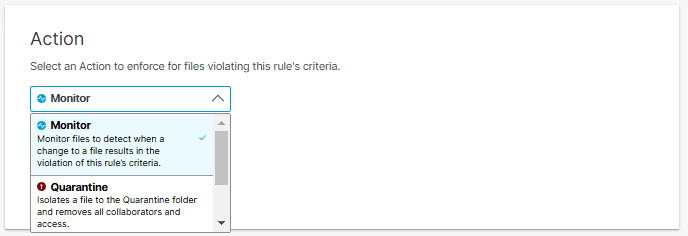
If you choose Quarantine for Microsoft OneDrive, Sharepoint Online, Box, Dropbox, or Google Drive:
- The file identified as exposing sensitive data is moved to the Cisco_Quarantine/DLP folder Secure Access created in the root path of the Global Admin who authorized the tenant.
- In lieu of the quarantined file, a text file is left in the original location with the name filename.ppt_Unique-Event-ID_Cisco_Quarantined.txt explaining to the original File Owner that the file is identified as exposing sensitive data and for more information to contact their organization administrator.
- The user who authorizes access to Secure Access will have access to the quarantine folder. All other accesses and collaborators are removed.
- Thus, we recommend that the admin add the relevant DLP Admins as additional collaborators to the folder.
If you choose Quarantine for ServiceNow:
- The file identified as exposing sensitive data is moved to a table named Cisco_Quarantine_Malware which can be access only by the admin user who authorized the ServiceNow tenant.
- A footprint is attached to the notes\activities area of the table the file is attached to. This footprint will notify users that the file has been identified as malware, and for more information they should contact their administrator.
- Note: Quarantine attempts may fail if the files have been locked or blocked by settings within their native platforms. Settings local to the platform where a file resides take precedence over Secure Access' ability to detect or remediate DLP violations or malware.
- Note: If your DLP rules process files from Microsoft OneDrive, SharePoint Online, Box, Dropbox, ServiceNow, or Google Drive and you restore a quarantined file that still violates rule criteria, the system will quarantine that file again. To prevent the system from quarantining the file again, remove the file's violation, or update the rule's criteria.”
- If you chose Revoke Access for Action:
- If you chose Google Drive for the Platform, select from the following options:
- Remove public link: Removes any file link that has public exposure.
- Remove share exclusively with internal users: Removes all internal users of files that were shared with few specific internal users.
- Remove share with any external user: Removes all external users. (External users are not part of the organization domain)
- Remove specific shares: Entered email addresses or group email addresses are removed.
- Remove org-wide share link: Removes any share permission with the entire organization.
- Remove owner: Removes the file owner and transfers ownership to a new email address.
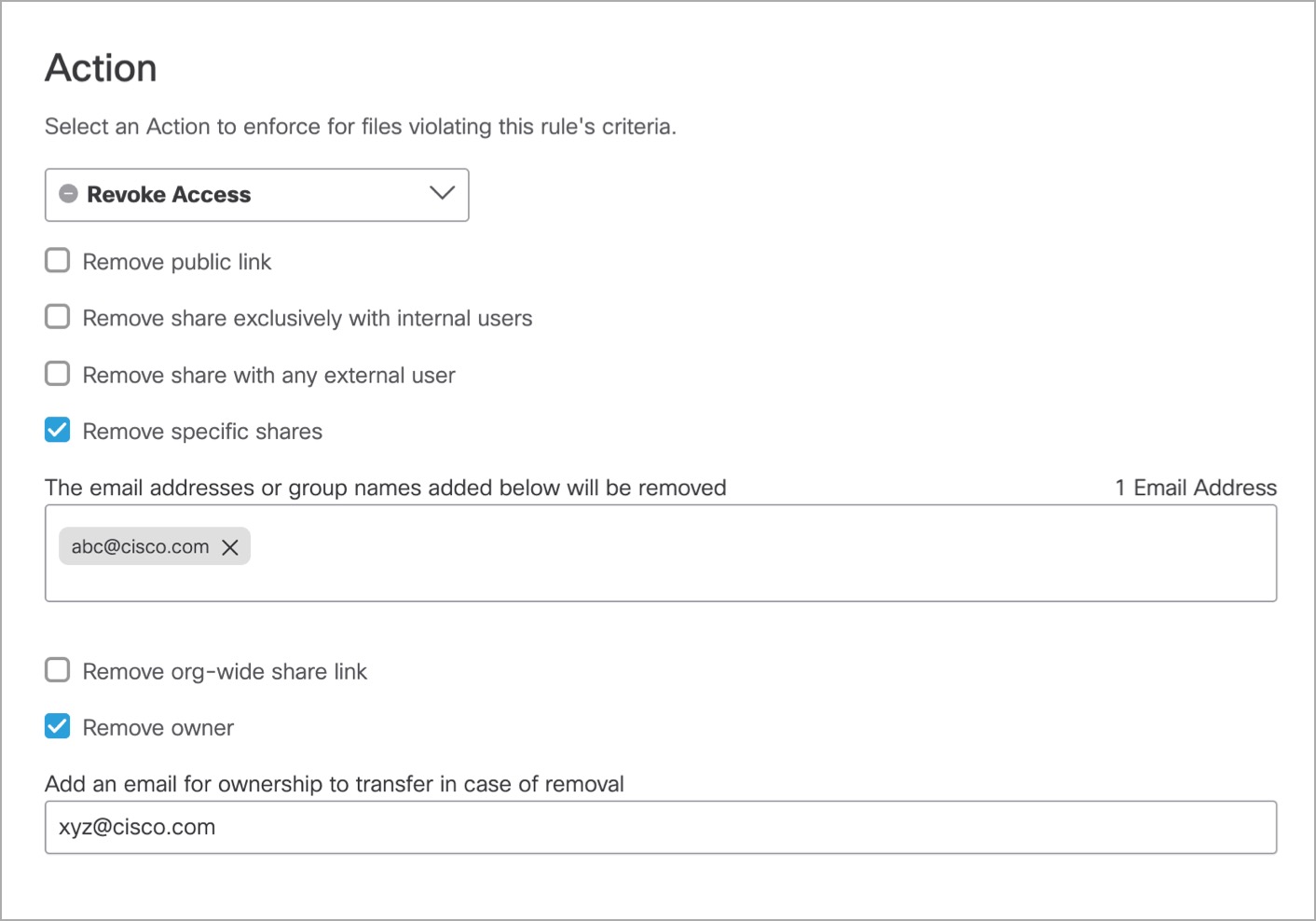
- If you chose Microsoft 365 Sharepoint Online or Microsoft 365 OneDrive for the Platform, select from the following options:
- Remove public link: Removes any file link that has public exposure.
- Remove org-wide share link: Removes any share permission with the entire organization.
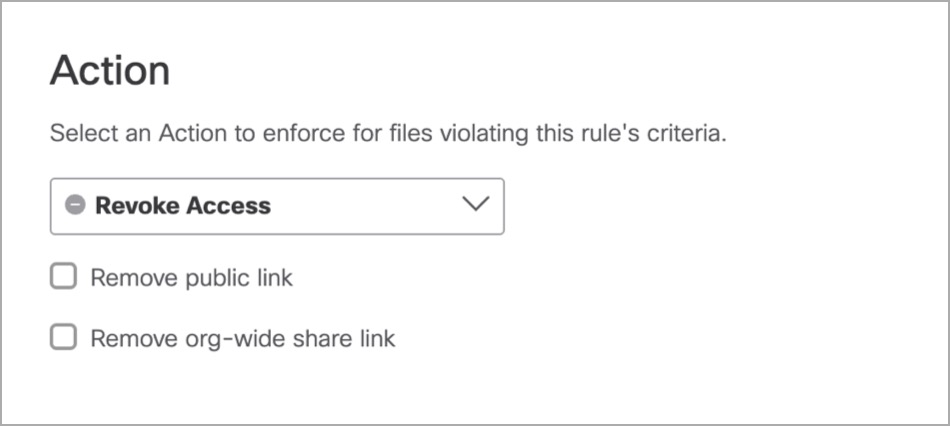
- If you chose Box for the platform, select the following option:
- Remove public link: Removes any file link that has public exposure.
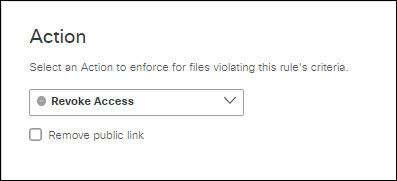
- If you chose Dropbox for the platform, select from the following options:
- Remove public link: Removes any file link that has public exposure.
- Remove share exclusively with internal users: Removes all internal users of files that were shared with few specific internal users.
- Remove share with any external user: Removes all external users. (External users are not part of the organization domain.)
- Remove specific shares: Entered email addresses or group email addresses are removed.
- Remove org-wide share link: Removes any share permission with the entire organization.
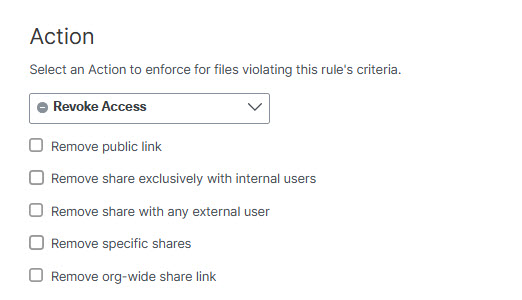
- Under User Notifications click the User Notifications toggle button to enable and configure an email notification to be sent to one or both of the following users:
- The owner of the file associated with a rule violation (for Outlook, this is the sender of the email).
- The user who performs an action that triggers a rule violation (for Outlook, this is the sender of the email).
You can use a default email template provided by the system, or create your own custom template.

A. Click the User Notifications toggle button.
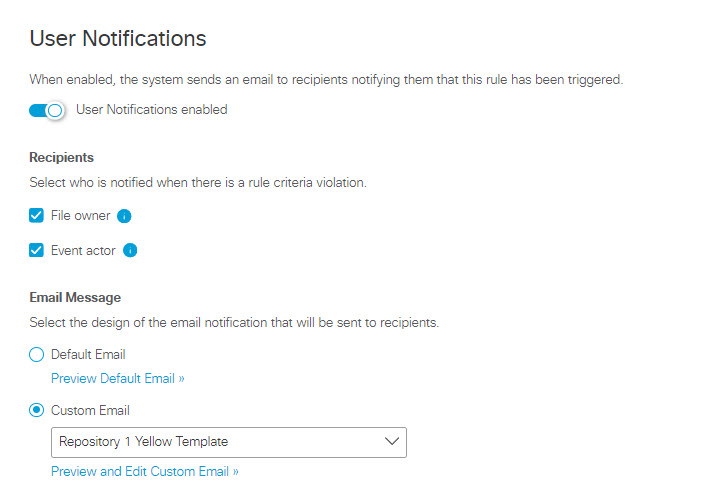
B. Select one or both of the following email recipients:
- File owner - The owner of the file associated with the rule violation
- Event actor - The user who performs an action that triggers the rule violation
C. Choose the email template:
To Use the Default Email Template:
a. Click Default Email.
b. To preview the content of the email that will be send to users, click on Preview Default Email. You can review the email subject line and text, but you cannot change it.

c. (Optional) To send a test copy of the email to an address of your choosing, enter an address in Preview Test Email and click SEND PREVIEW to send the message. (By default the system uses the email address of the logged in user.)
d. Click CLOSE to return to the Data Loss Prevention Policy page.
To Use a Custom Email Template:
a. Click Custom Email.
b. From the drop-down list, select an existing custom template, or choose CREATE CUSTOM TEMPLATE. If you select an existing custom template, you can click Preview and Edit Custom Email to review and change the template.
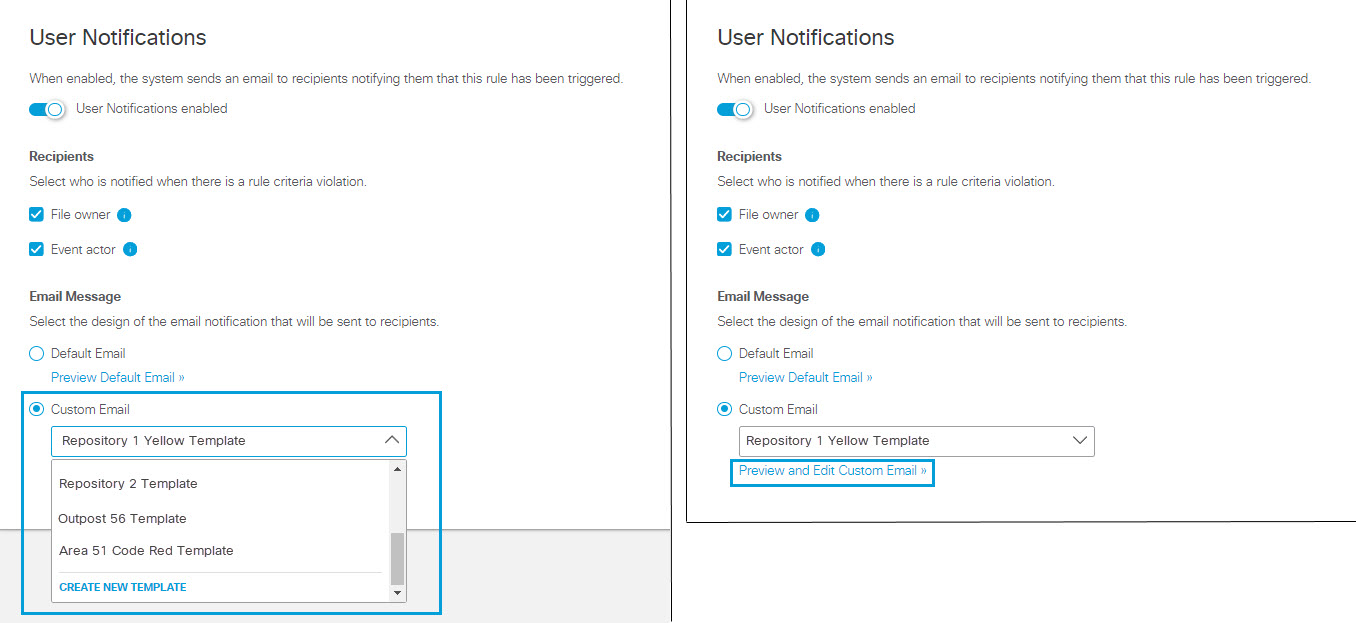
c. When you choose to create or edit a custom template for email notifications of policy violations you will see one of these two dialogs, which are almost identical:
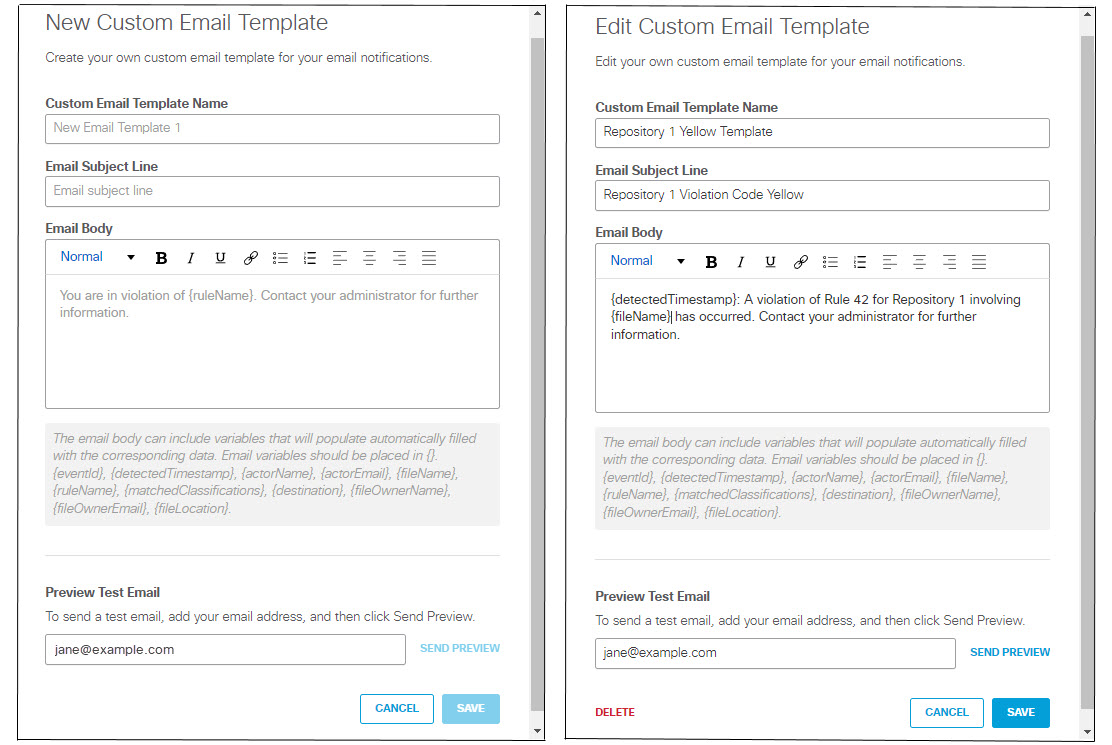
The Edit Custom Email Template includes a DELETE link which you can use to delete a custom template that is no longer needed. You may not delete a template that is in use by any rule.
To create a new template or change an existing template:
A. Enter a unique Custom Email Template Name.
B. Enter an Email Subject Line.
C. Enter the text of the email in the Email Body text box.
The email text can include the following variables, which you must enclose in braces ( {} ):
- {eventId} - The unique identifier the system generates for the policy violation event.
- (detectedTimestamp} - The date and time the violation was detected, formatted as shown in this example: "Oct 1, 2023 at 14:04 UTC"
- (actorName} - Name of the user whose action triggered the violation. (The system gets this from the tenant associated with the violation. Depending on application and file settings, this information may not be available, in which case the the system replaces this variable with blank text.)
- {actorEmail} - Email address of the user whose action triggered the violation. (The system gets this from the tenant associated with the violation. Depending on application and file settings, this information may not be available, in which case the the system replaces this variable with blank text.)
- {fileName} - Name of the data file that triggered the violation.
- {ruleName} - Name of the rule that was triggered.
- {matchedClassifications} - The data classifications associated with the violation. (See Manage Data Classifications.)
- {destination} - The application or platform type of the tenant associated with the violation. (E.g., Google Drive or One Drive; see Manage Tenant Controls.)
- {fileOwnerName} - Name of the file owner. (The system gets this from the tenant associated with the violation. Depending on application and file settings, this information may not be available, in which case the the system replaces this variable with blank text.)
- {fileOwnerEmail} - Email address of the file owner. (The system gets this from the tenant associated with the violation. Depending on application and file settings, this information may not be available, in which case the the system replaces this variable with blank text.)
- {fileLocation} - The file URL.
Note: The system replaces a variable with blank text if there is no value assigned to the variable or if an invalid variable name appears within the braces.
D. (Optional) To send a test copy of the email to an address of your choosing, enter an address in Preview Test Email and click SEND PREVIEW to send the message. (By default the system uses the email address of the logged in user.)
E. Click SAVE to return to return to the Data Loss Prevention Policy page.
- Click Save. All fields must have options selected to save.
Supported Applications < Add a SaaS API Rule to the Data Loss Prevention Policy > Add an AI Guardrails Rule to the Data Loss Prevention Policy
Updated about 2 months ago
